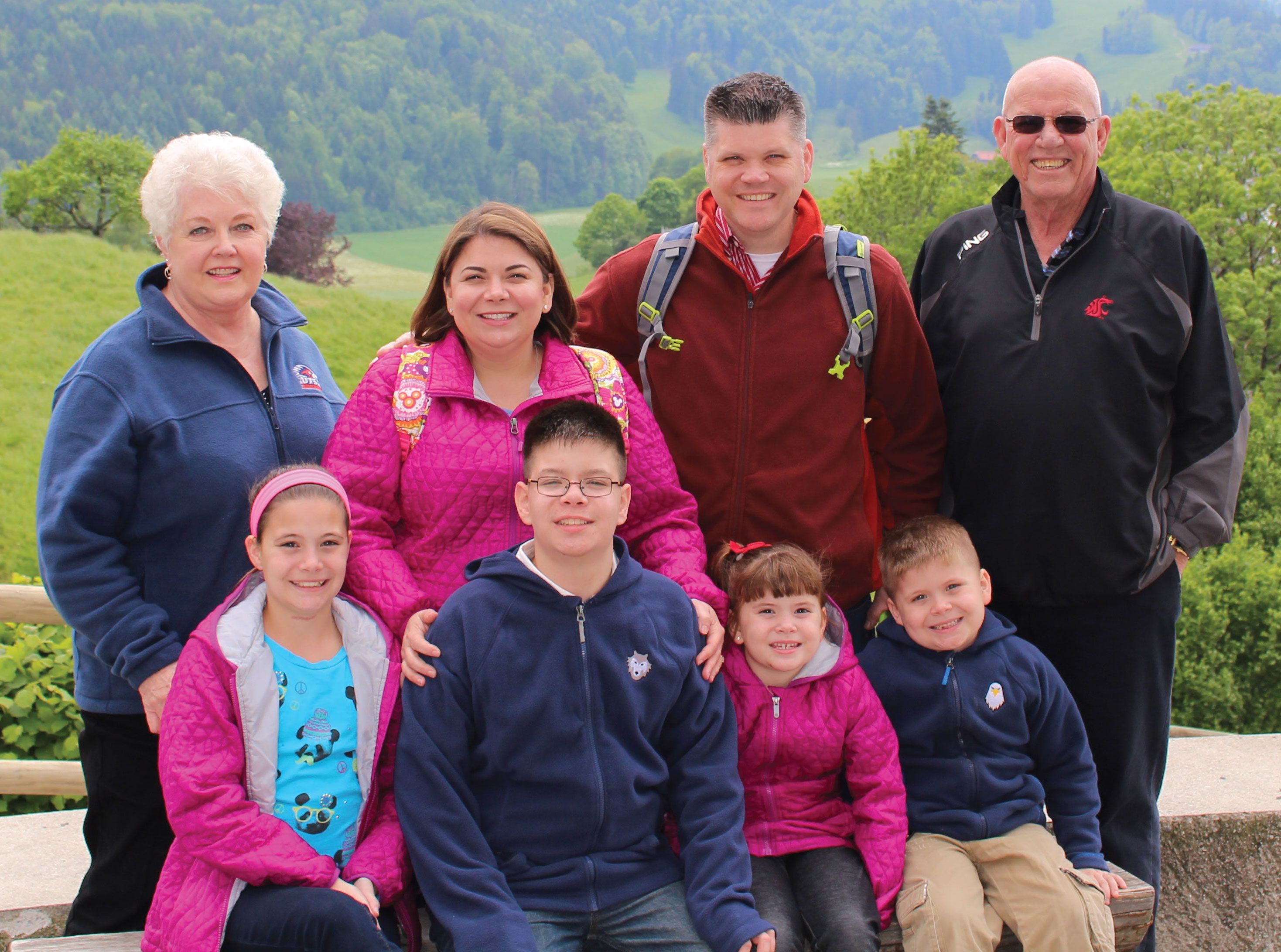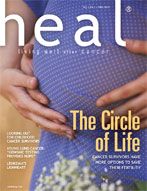Publication
Article
Heal
The Circle of Life: Saving Fertility After Cancer
Author(s):
Cancer survivors have more options to save their fertility.
Greg Aune, now in his mid-40s, still recalls it as the most embarrassing moment of his life. He sat with his mother at age 16 and answered questions about his sex life. Did he masturbate? Was he sexually active? Did he have a sexually transmitted disease?
“It was 1990 and thinking about long-term survival after cancer treatment was just beginning,” he says. “But my mom kept pushing it and asking questions about fertility.” If it had been up to Aune and the oncologist, the subject would have never come up.
When the oncologist finally told her that her son’s treatment could leave him sterile, the family had to quickly find a reproductive clinic that could collect and freeze Aune’s semen so they could begin treatment for his Hodgkin lymphoma.
The hospital where he was being treated didn’t offer any help or specialists, so the family travelled five hours to Seattle, Washington, from their home south of Spokane to a reproductive clinic where they could collect and store Aune’s semen — and his mother’s potential grandchildren.
“The oncologist didn’t prevent it, but my mom really had to push. And there were some aspects of my case that made him want to start treatment quickly,” Aune recalls.
Aune had to donate four days in a row to ensure he had captured enough viable sperm when he decided to use it.
At the time of his diagnosis Aune’s age put him in the adolescent and young adult (AYA) category of cancer patients.
GREG AUNE (second from right on top row) with his family.

GREG AUNE (second from right on top row) with his family.
While a cancer diagnosis is devastating no matter the patient’s age, those in the AYA community have to address added issues that include lack of insurance, support and the possibility that the disease or its treatment will leave them infertile.
And, while today the ways to overcome infertility have increased, numerous studies have found that many oncologists are still not discussing the issue with their patients of childbearing age, and those who do are choosing patients selectively.
Authors of a new study published in the journal Cancer in October 2015, reported that whether doctors talk about fertility with AYA patients is determined by medical factors, patient socioeconomic data and childrearing. And, whether patients bring it up with their oncologists is determined by similar issues. For example, oncologists told researchers that they would not bring up semen banking with patients who appeared not able to afford it, or if they thought the risk of fertility loss was low. Women with children under the age of 18 were less likely to want information on fertility.
The results of the study, conducted by the numerous cancer centers in the AYA Hope Study Collaborative Group, highlight the need for better insurance coverage for fertility preservation and increased awareness of fertility preservation options. The study also paints a picture of how arbitrary the discussion of fertility has become.
Helen Parsons, an author of the Hope study and assistant professor in the department of epidemiology at the University of Texas Health Science Center in San Antonio, explained that the study also looked at positive and negative impacts of cancer in a variety of other areas such as employment, relationships, sexual functioning and plans for a family.
“The negative impact on their life plans could be based on a variety of reasons and not necessarily related to fertility,” she says. “But 57 percent of the participants said the cancer had had a negative impact on plans for having children.”
The Next Step
Even Aune says he and his oncology colleagues could still do a much better job of fertility counseling, and in some respects, not much has changed since he was diagnosed 25 years ago. Now a researcher and oncologist in the Division of Hematology- Oncology at the Greehey Children’s Cancer Research Institute at the University of Texas Health Science Center in San Antonio, Aune says the lack of attention to fertility persists despite the American Society of Clinical Oncology’s (ASCO) recommendations in 2006 that oncologists who were seeing reproductive-age patients should address potential treatment-related infertility with them or, in the case of children, with their parents.The challenge for oncologists in following these recommendations comes in deciding what to communicate to their patients, says Kristin Smith, patient navigator for fertility preservation at the Robert H. Lurie Comprehensive Cancer Center in Chicago.
“If there are no reproductive endocrinology offices in the center, where do patients go?”
Smith explains that patients who come to her facility are fortunate because they have all the services available in the center.
“Patients can see their oncologist and walk to the reproductive endocrinology or urology offices to move forward with fertility preservation as soon as possible. Patients who have insurance through Illinoisbased employers are also typically fortunate in that Illinois is a fertility mandate state, meaning that most of these insurance plans offer fertility coverage.”
Smith begins counseling her patients by discussing how the proposed treatment can impact both male and female fertility and then describing the available options. Northwestern has a questionnaire within the medical record that oncologists answer to ascertain if fertility was discussed with each new, reproductive-aged patient.For men, she says, collection of semen for storage requires significantly less than what women face in money, procedures and storage.
For Aune, the gathering of his semen took four days, but it was stored for more than a decade before he used it. He took over the estimated $800 annual charge when he married while in medical school. His wife, Christie, a neonatologist, was undeterred at the prospect of using frozen sperm to have children since she had experienced Hodgkin lymphoma in her own family.
Women’s choices may involve invasive medical procedures at a time when they are already dealing with a potentially life-altering illness. In addition, the most common fertility preservation option — egg or embryo freezing — typically costs in the thousands, not the hundreds, and insurance usually doesn’t pay for these services.
And, because freezing eggs, the most common fertility option for women, takes four to six weeks, potentially life-saving treatment might have to be delayed — a time delay that many children’s hospitals will not accommodate, she says.
New procedures have been added to hopefully increase a woman’s chances of preserving fertility. If freezing eggs isn’t an option or doesn’t work, there are assisted reproductive technologies such as intrauterine insemination and in vitro fertilization, or third-party options such as donor eggs or adoption.
More experimental procedures such as moving the ovaries out of the way during radiation or removing some ovarian tissue that would be replaced later are showing promise, but still considered experimental.
Parenthood
Smith recommends to her patients that they begin looking for financial help before beginning the process on one of the many websites that offer support such as www.resolve.org , the National Infertility Organization.When it’s time to become parents, Smith remains available to survivors to look at their options — even when they used no fertility-sparing methods.
“We don’t know exactly how much damage will be done by treatment. We are looking at adult survivors of childhood cancer and doing post-treatment semen analysis to determine if it’s OK to father a child.”For women, a reproductive endocrinologist can look at hormone levels and perform imaging studies to look at the ovaries to see if they have been damaged.
Survivors should ask their medical team if it’s OK to attempt pregnancy, she says. Semen analysis can help men, but reproductive analyses are more complicated for women. Many continue ongoing hormonal treatment for their cancer that has to be stopped, and it takes two months to wash out of the system.
Smith says her department has also screened adoption agencies to determine if they discriminate based on cancer history, which some do.
A Happy Outcome
“Survivors need to know that they are not alone,” says Smith. “There is a shift in oncology care to ensure that fertility is addressed prior to treatment, and there is ongoing research for less toxic therapies.” Smith also wants survivors to know that she will talk to anyone who calls the Oncofertility Consortium — no matter where they were treated.In 2003 Aune held his twins, Noah and Emma, born with the sperm he banked in 1990.
“For many years before we got pregnant my mom and I had talked about how grateful we were to have that banked sperm,” he said.
The twins were born at 28 weeks’ gestation after using IVF, which required removing Christie’s eggs and fertilizing them before returning them to her body. They used three eggs and two were viable, resulting in Noah, who weighed 1 pound and 3 ounces and Emma, who was 2 pounds and 1 ounce. Now in the sixth grade, both twins are fine.
While he can’t attribute their prematurity to the IVF or thawed sperm, he says it may have been a factor.
In 2008 the Aunes did it again, and, again, had fraternal twins, Elijah and Sophia, who were also premature at 35 weeks.
H
“When I talk with my teens in the pediatric oncology unit, I see them rolling their eyes just like I did,” Aune says. “All I can tell them is that someday they will thank their mother.”






